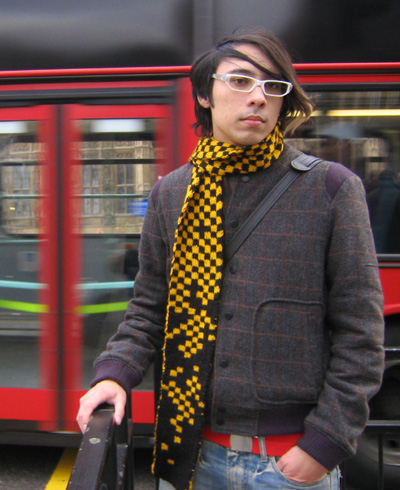
 Note:
To make this pattern easier to understand, the predominantly
yellow (MC) side will be called the RS, and the predominantly
black (CC) side will be called the WS.
Note:
To make this pattern easier to understand, the predominantly
yellow (MC) side will be called the RS, and the predominantly
black (CC) side will be called the WS.
CO 48 stitches using CC. I recommend using a cable
cast on, but a tubular cast on is also nice for
double knitting.
Now it's time to add the second color, and work
the first row. You will have to get used to holding
both yarns at once. Throughout, you carry both colors
forward or back between the needles before each
stitch, though you are only knitting or purling
with one color at a time.
The first row is worked entirely in MC on the
RS, and CC on the WS. Knit the first stitch using
MC. Bring both yarns between the needles to the
front of the work. Purl the next stitch using CC,
then bring both yarns between the needles to the
back of the work. Knit the next stitch in MC. Continue
working in this way to the end of the row.
You should have what looks like the first row
of 1x1 rib, but with the purled stitches in a different
color from the knitted ones. If you are using black
and yellow too, it'll look pleasingly like a bee.
Turn the work, so the WS is facing. The last stitch
of the previous row was worked using CC, so the
first stitch of this row will also be worked using
CC.
Bring the strand of CC up underneath the strand
of MC, effectively twisting the strands around each
other, and knit the first stitch using CC. Bring
both strands of yarn between the needles to the
front of the work and purl the next stitch using
MC. Bring both strands of yarn between the needles
to the back of the work and knit the next stitch
using CC. Continue working in this way to the end
of the row.
You have just worked 2 rows in double-knit stockinette
stitch, with one side (RS) worked in MC, and one
side (WS) in CC. Work 12 more rows in this way.
Remember always to wrap the yarn for the first stitch
of each row, around the other yarn, before working
the first stitch.
Begin Chart Pattern:
When working from this chart, the odd-numbered rows
will be RS rows, and the even-numbered rows will
be WS rows. The MC (white) squares indicate that
a MC stitch is worked on the RS, and a CC stitch
is worked on the WS. CC (black) squares indicate
that a CC stitch is worked on the RS, and a MC stitch
is worked on the WS.
This means, for example, that if you are working
a WS row, and you see a MC square, you would knit
that stitch using CC, and purl it using MC, so that
the stitch would be a MC stitch on the RS.
Work through all rows of the chart, then repeat
rows 97-102 until the scarf is the desired length.
Most of the scarf will be checkered, though you
can always throw in the odd 'missing'
patch if you feel if looks right. It breaks things
up if you get bored and, as Uslan often says, consistency
is overrated.
BO all sts using CC.

